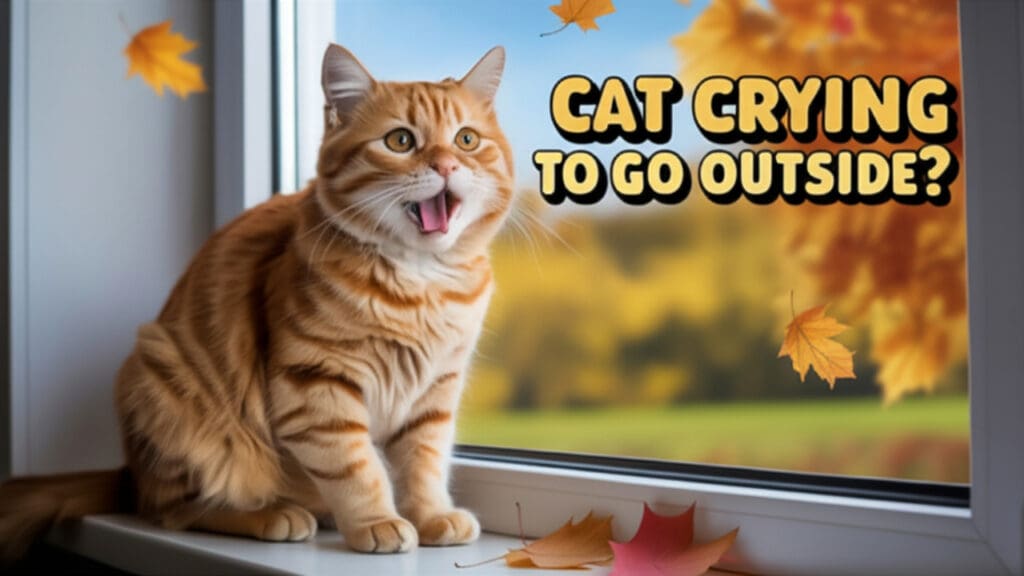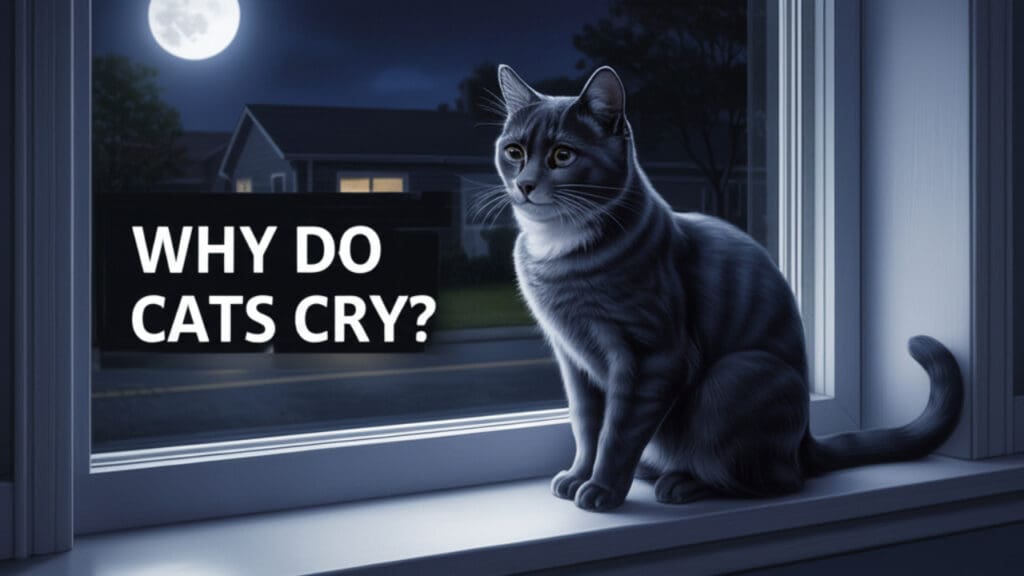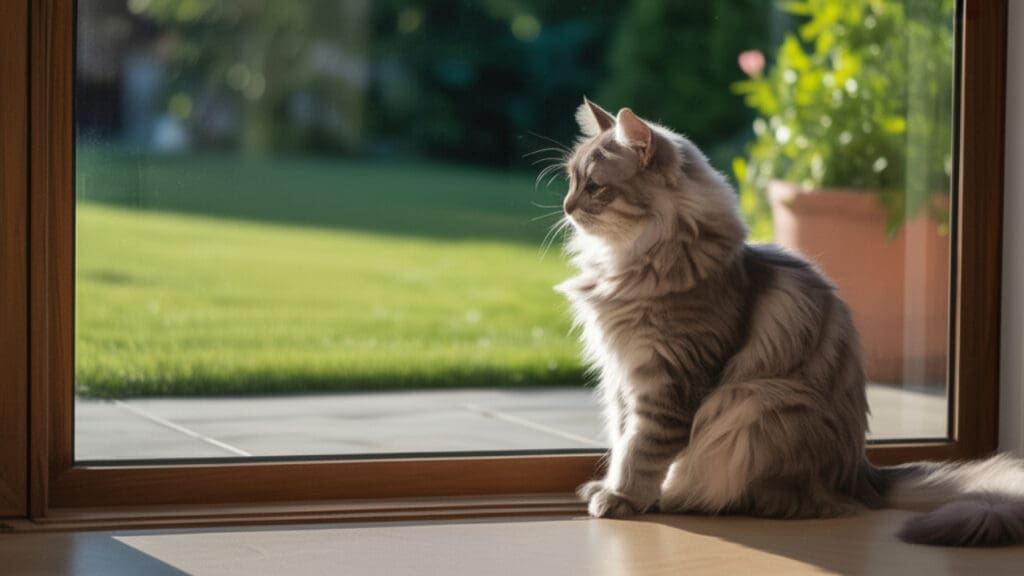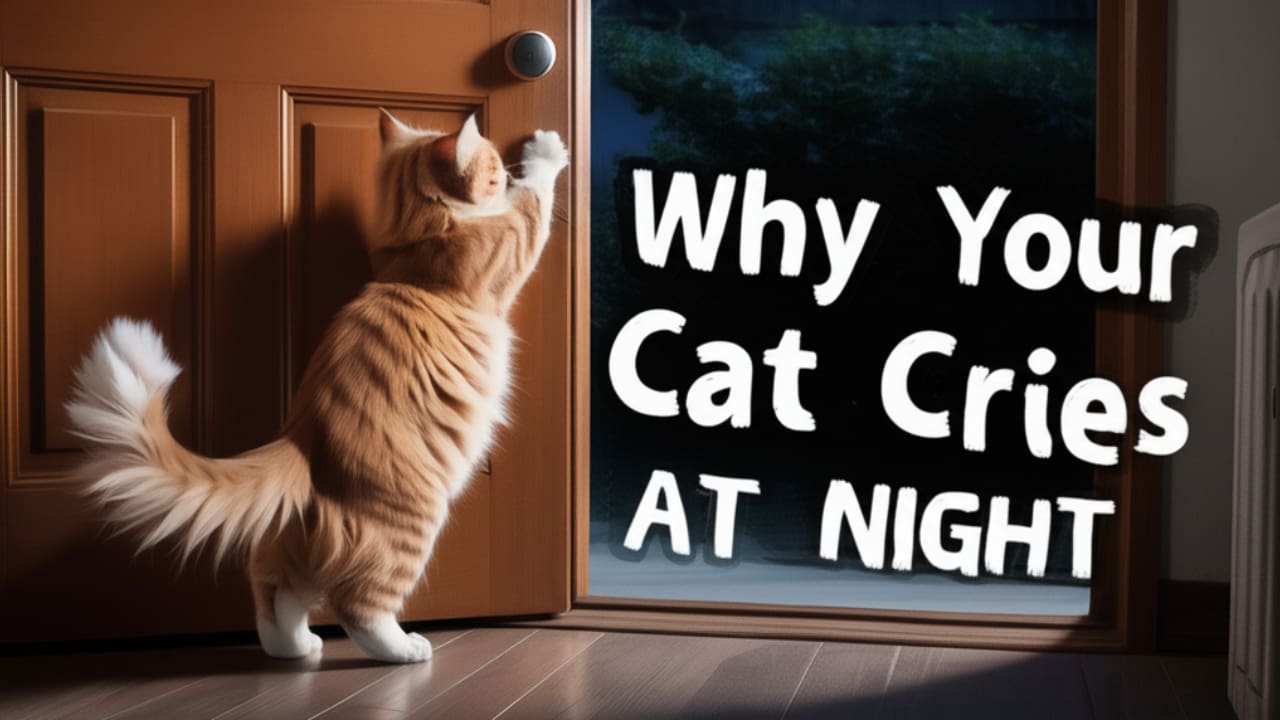Cat Crying to Go Outside? (2025 Guide): Reasons, Nighttime Behavior, Training Tips, Health Signs, and Safer Alternatives
Of course, your cat is pacing by the door and meowing nonstop at 2 a.m. Do they look like they crave the outdoors? And is their constant cry disrupting your sleep? We’ve got you.
You see, there’s probably a good reason as to why your cat’s crying to go outside, especially at night. It’s unlikely that they just want to go out. Reasons could be because their environmental needs are not met, they’re stressed, or sometimes there could be underlying health issues.
Our cat may also be reacting to sights and sounds outside (like seeing another animal). And that could awaken their natural instincts. But in some cases, their loud meows could just be telling you that they are bored. Also, our furball’s crepuscular nature may play a role, making them more active during dusk or dawn.
To help with this, we pet parents could try enriching our little ones’ indoor environment. It could be vertical space, interactive toys, or just a secure catio.
Behavior conditioning also helps. For example, you can try withholding attention at the door. It could help reshape your cat’s behavior over time without causing much frustration for either of you.
In this article, you’ll learn how to interpret your cat’s meows. We’ll also look at when you should visit your vet and explore safe alternatives to help satisfy your baby’s instinct. Stay tuned.
Why Does My Cat Keep Meowing, Wanting to Go Outside?
First, know that our feline friend meows for a lot of reasons. But if your cat keeps whining to go outside and is persistent about it, then it could be because of a blend of reasons involving instinct, habit, and environment.
Our cats are curious and territorial. So, their meowing at the door may be a way of saying they want to explore, hunt, or simply patrol their familiar outdoor space. This desire is common in cats that have previously had outdoor access or lived in a place with lots of environmental stimuli, like birds chirping.
Sometimes, your cat just picks up the behavior. You have probably let them out previously because they meowed. And they think it’ll work this time around if they do the same. Your reaction to this actually helps reinforce the behavior.
Now, consider the indoor environment. Is it meeting the physical and mental needs of your cat? Know that your little one may want to go out because of under-stimulation, boredom, or a lack of enrichment activities. Nobody wants to stay idle all the time in the house after all.
In some cases, your cat’s meowing can mean stress or anxiety, especially if it’s persistent. Maybe you’ve recently made changes in the house. Perhaps it’s a routine change. If there are new animals outdoors, and your cat can see them, they may also meow.
What Does It Mean When a Cat Cries to Go Out at Night?

So, your cat’s crying to go outside at night (and only at night). This is probably thanks to their instinctual behavior patterns.
First, know that your cat is crepuscular. This means they are likely to be more active during the evening and early morning hours. Because of this, your little one may have a strong urge to hunt, explore, or patrol their territory at night. And this is especially the case if they sense movement or noise outside.
Recent 2025 research shows that artificial light exposure significantly affects cat activity patterns, with cats exhibiting shortened 22-23 hour circadian rhythms when exposed to different lighting conditions. This disruption can intensify nighttime restlessness and vocalization behavior.
Now, sometimes the behavior is just a reflection that they are bored or restless. If they had nothing to do for the entire day, cooped up in the house while you were at work, then it’s only sensible that they want stimulation at night when their energy level is at its peak.
That said, if the meowing is sudden or usually intense, you could be looking at a stressed-out cat. Perhaps there are changes in the house that are throwing them off, like a change in feeding schedules or lighting patterns.
At times, this nighttime behavior may have been something reinforced by previous experiences. If you’ve ever let your cat win out at night before (i.e. they meow, and you let them out), then it’s likely that your baby’s doing the same thing to get what they want.
Is Your Cat Crying to Go Outside All the Time? Behavioral and Environmental Triggers Explained

Yes, that meowing probably isn’t spontaneous. Your cat is very likely responding to a combination of internal drives and external environmental cues.
This means your little one could be under–stimulated indoors. They lack the opportunities for doing activities like climbing, playing around, or engaging in something sensory (i.e. see, smell, touch something for exploration). In such cases, the outdoors will look like a source of excitement, something new that screams freedom.
You can take note of some behavioral triggers. Has your cat had previous outdoor access? Is it because of seasonal changes? Does your baby only meow when they see animals passing by? Your cat may also feel a territorial pull that makes them want to patrol or mark boundaries.
As for the environment, see if there’s anything you’ve made changes to recently. If you’ve rearranged the furniture, that could be a cause. Your baby also responds to new pets or guests. And it makes going outdoors seem like a perfect escape.
Can a Cat Screaming to Go Outside Be a Sign of Stress or Health Issues?

Your cat’s meowing is no different from a scream to you now? This may be saying that there’s a deeper problem.
Note that occasional vocalizing is normal for your feline friend. But if it’s an excessive or intense cry, it’s probably a distress call. Think stress, anxiety, or even medical conditions. Your little one’s screams may be pointing to issues like cognitive dysfunction, hyperthyroidism, or sensory loss.
Look out for stress-related triggers. It could be your recent changes in the house. And in response, your cat is probably trying to “escape” or cope. Your baby may sometimes feel trapped at home, too, especially if they’re cornered or overstimulated. This largely applies to households with many cats.
In some rare cases, your cat’s behavior could be due to pain or discomfort. Then, the act of trying to go outside becomes a displacement behavior. It’s like an outlet for tension, be it physical or emotional.
See if your cat’s screaming is sudden and persistent. Does it come with other symptoms like appetite loss, excessive grooming, and litter box avoidance? We recommend you involve a vet in such cases.
Studies show that about 1 in 4 cats seen by vets show signs of anxiety. Ongoing stress can cause serious health problems like bladder inflammation (FIC) and skin issues.
In homes with multiple cats, a stressed or overwhelmed cat might try to run outside-not because they love the outdoors, but as a way to escape and cope with anxiety.
Indoor vs. Outdoor Cats: Pros, Cons, and Common Misconceptions
Now, you may be busy, and you have to make a decision. Should you just keep your cat indoors? Or can you give them outdoor access? This could affect everything from their safety to their behavior after all.
You may think your cat will be happier to be able to roam freely outside. But this is a common misconception. Letting cats outside might help with some behavior problems, but it comes with serious risks. Indoor cats usually live 13 to 17 years, while outdoor cats often live only 2 to 5 years.
Almost 4 out of 10 sudden deaths in outdoor cats are caused by car accidents, and 87% of serious injuries are from being hit by vehicles.
Outdoor cats are also nearly 3 times more likely to catch infections than indoor cats. Common diseases like FIV (feline immunodeficiency virus) and FeLV (feline leukemia virus) are found in 3.6% and 3.1% of outdoor cats, respectively.
Indoor cats, however, benefit from stability. They face lower health risks and generally have longer lifespans. It’s a trade for security. Still, your little one needs enough enrichment to keep them engaged.
Provide them with interactive toys, vertical space, play, and visual stimulation. It’s often a matter of keeping your baby from being bored. They are already physically safe and well-fed. You just need to cater to their other needs (or wants).
How to Calm a Cat That Keeps Whining to Go Outside: Training and Enrichment Techniques
There’s a reason for your cat crying to go outside. They’re likely looking for stimulation, attention, or maybe they just want that previously rewarding experience.
So, with this in mind, you should come up with a combination of behavior training and environmental enrichment. When done right, you can expect to minimize or even get rid of the nighttime meows that keep you from your beauty sleep.
First, start by creating a more engaging indoor environment for your little furball. Perhaps you can offer window perches with a view of the outdoors. It sounds relaxing just thinking about it. You could try interactive toys (rotating them with new ones) and puzzle feeders, too. These could help stimulate your cat and reduce the boredom they feel.
If your little one has a lot of energy, try dedicating some time to play with them. Be consistent and do this every day. You can try wand toys or laser pointers. They help burn off the excess energy your cat has stored up.
Next is behavioral training. You’ll need to set clear boundaries and avoid reinforcing the negative behavior. This means if your cat cries at the door, you don’t respond to it immediately. Don’t scold, no punishment.
Instead, reward their calm behavior with treats or affection. Again, be consistent with the routine. You can also use clicker training for this.
Safe Alternatives to Letting Your Cat Roam Outdoors Freely
Sure, it’s easy to just let your cat go out roaming, unsupervised, even. It’s a natural solution, and it stops the meowing, right? But, it is also a risk.
Let’s explore some safe alternatives. We’re not saying that it’s not good to let your cat out. You have options, and these might work better for you.
One effective solution is a catio. This is essentially an enclosed outdoor space. It provides fresh air and visual stimulation, yet it doesn’t put your little one in harm’s way. Catios come in different sizes and designs. There are those with window-mounted perches. Some have large walk-in structures connected to the house. If your cat keeps crying to go outside, perhaps consider getting one of these.
As for indoor alternatives, try getting a bird feeder outside your window for visual enrichment. It makes life less boring seeing some bird companions from time to time, after all. You can also try indoor grass or catnip plants. They stimulate nature.
Additionally, add more vertical spaces like cat trees, wall shelves, and tunnels. It’s great for encouraging physical activity and exploration.
What Outdoor Cats Really Do
Recent GPS studies on 92 pet cats showed that most cats don’t wander far from home. On average, they stayed within 100 meters (about 330 feet) of their house.
Their usual roaming area was around 2.6 hectares. Male cats covered more ground (about 3.7 ha) than female cats (about 1.5 ha).
So, instead of exploring far away, most outdoor cats actually spend their time close to home in familiar places.
When Should You Be Concerned? Medical and Emotional Red Flags in Your Cat Crying to Go Outside
Our cats meow or whine to go outside due to instinct or habit. That’s quite normal. But if the behavior is persistent or sudden, then it might be a concern.
Don’t ignore and observe. Is the cry getting louder? Is it more frequent? Does it seem desperate or distressed? These could be a medical or emotional red flag.
Some health-related causes may include cognitive dysfunction, especially in older cats, or undiagnosed pain. Hyperthyroidism and urinary tract issues are also common concerns. Your cat may be restless and meow more when plagued with these conditions, particularly during nighttime hours, when they know you’re around.
Your cat may also feel anxious or depressed. Certain “small” things, like household changes, can cause stress. New furniture arrangements, new pets, moving house, or an altered routine can all contribute to compulsive behaviors. And that includes meowing or vocalization.
Pay close attention to your precious one. See if they are starting to isolate themselves. Are there any changes in eating habits? Do they seem unusually alert or agitated? If these behaviors come out of nowhere and are intense, it’s best to talk to a vet and arrange for a checkup.
Supporting Your Cat’s Needs Indoors with Dr. Elsey’s
Really, keeping your cat in the house is not a sacrifice of their happiness. You just need to find ways to meet their physical, mental, and emotional needs. Perhaps you might want to check out Dr. Elsey’s for more tips and advice.
Dr. Elsey’s is a veterinarian-founded company that follows a “cats before profit” philosophy. They mainly focus on offering products and expert advice to help your feline friend thrive inside the house. The company website features useful and practical information on why keeping your cat indoors can be safer, and even tips on how to reduce your cat’s stress while you’re away.
Remember, you should engage in interactive play to help channel your little one’s natural instincts. And Dr. Elsey’s recommends that we try daily play sessions with vertical spaces, with the help of wand toys and puzzle feeders. These can provide our cat with the stimulation that playing outdoors offers.
Next, reward your cat’s interaction with nutritious treats. You may find Dr. Elsey’s Protein Bites to align with your cat’s nutritional requirements. These treats are available in chicken, pork, and turkey. We especially like these products because they are made with single-source animal protein to help support our cats’ muscle health. And they provide a satisfying “catch” to your little feline pal after the chase.
Also, know that your cat needs a high-protein, animal-based diet. It’s important to balance their energy level, and it helps them to be less restless at night. For this, you could try out Dr. Elsey’s Cleanprotein™ kibble. These come in lots of flavors, including chicken, salmon, turkey, pork, duck, and rabbit (the last two are mixed with chicken, by the way).
Combine these natural-prey tasting kibbles with your puzzle feeder or even hide them in different places to play with your feline buddy. It’s more engaging for your cat’s senses. And it could actually turn mealtime into a mentally stimulating hunt.
FAQs About Your Cat Crying to Go Outside
1. Why does my cat cry to be let out?
Your little one may just be curious. It could also be a habit or territorial instinct. If you’ve let them out before after their meowing, the behavior might be something you’ve reinforced.
2. Why does my cat cry when I go out?
They may be experiencing separation anxiety. Or perhaps it’s a disruption in their routine. Your cat’s vocalization is likely a way to cope with your absence.
3. What does it mean when your cat always wants to go outside?
If the want is constant, then it could be boredom or high prey drive. Sometimes, it’s a learned behavior from previous outdoor access snowballing into expectation.
4. Do cats get sad if you don’t let them outside?
Some cats may become restless or frustrated if you don’t let them out. But most cats can thrive indoors as long as you provide proper enrichment and stimulation.
5. Why has my cat suddenly stopped wanting to go outside?
This might be due to a negative outdoor experience. It is also possible that there might be an underlying health issue. Keep an eye out and observe for other behavioral changes.
6. How does letting a cat outside affect its behavior indoors?
Playing outside can make your cat use up more energy, and it could reduce boredom. But, this might also lead them to vocalize (wanting to go out), mark territory, or try to escape more often.
7. Can you train a cat to stop meowing at the door?
Yes. Be consistent with your redirection, use positive reinforcement, and make sure to provide environmental enrichment. It’s likely you can train your cat to reduce this behavior over time.
8. Is it cruel to keep an indoor cat from going outside?
Not at all. Remember, indoor cats usually live longer and enjoy safer lives. You just need to meet their needs with proper mental and physical engagement at home.
9. What is a catio, and how does it help with outdoor cravings?
A catio is a secure outdoor enclosure. It allows your cat to experience nature safely. And this often reduces vocalization and door-related behaviors.
10. Why is my cat crying to go outside more at night?
Nighttime meowing is likely due to your cat’s natural activity cycle. It could also be because of increased outdoor stimuli after dark or a lack of stimulation during the day.
Stopping Your Cat Crying to Go Outside: Creating a Calmer Environment
Now you know that your cat crying to go outside isn’t just a random thing. Your baby’s trying to communicate with you, and you just need to learn to read them.
Remember, the behavior can stem from instinct, habit, stress, or even a medical issue. So, stay alert and take in all cues. Don’t fret, be patient.
Provide your cat with a more enriching indoor environment. Explore other safe outdoor alternatives like a catio. Take your time to figure out the best way to address the issue. Satisfy your little one’s needs without compromising safety.
As a final note, be consistent with your chosen approach. Research and take in the right insight before you make a decision. You can surely help minimize the behavior and build a calmer, more connected relationship with your feline friend.
Does your cat cry to go outside, too? Tell us what time they usually start meowing in the comments down below. We’d love to hear it!








